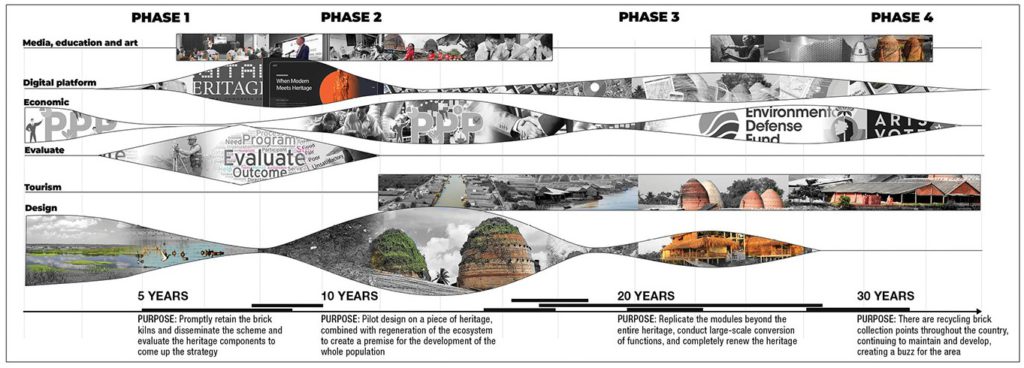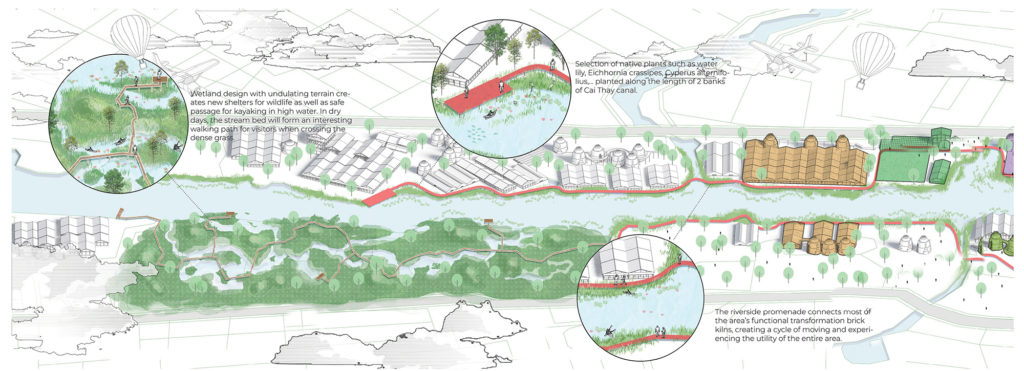Re-generational Architecture | FAP 2023 Second Place
September 20, 2023
CHALLENGES
Mang Thit is a famous pottery, brick-making craft village in Vinh Long Province, Vietnam, that is being shut down, partly due to the pollution of the brick-making process. As such, most of the kilns have been dismantled and destroyed due to the deterioration of the village.

The dismantling processes of unused brick production facilities has polluted the environment, thus affecting both human health and quality of agricultural products. When the brick industry declined, brick-makers had to return to farming in the context of shrinking agricultural land, or they had to leave to find jobs in industrial or service sectors with little or no training of skillsets.
SOLUTION
The team’s basic premise is to regenerate the heritage site on environmental, economic and social fronts by means of architectural and landscape mediations. Characterised by round brick kilns combined with river landscapes, the team hopes to revive the ruins of the old brick kilns to turn them into an ecological tourist destination so as to preserve them sustainably and to restore the livelihoods of the current local people, improving their quality of life while preparing the ground for the next generation. They intend to reposition the site as heritage to bring positive impacts to the culture, education and environment for future generations, positing that the younger generation in the future will be willing to pay a higher price to obtain meaningful experiences while tending to the interests and protection of the environment.
The team proposes a strategy along two dimensions of space and time, i.e., via a modular renovation approach to regenerate the site and phasing the processes involved. They aim to ‘reverse’ the site from one of polluting kilns to an eco-recycling centre (based on the easy recyclability of Mang Thit’s ceramic tiles), along with a redesign of the landscape to enhance flora and fauna ecosystems, taking into account the context of the Mekong Delta.

The project’s solutions are to recycle/reuse materials, evaluate the typology of the complex of brick kilns, solve the consequences of environmental pollution on the wetlands due to the brick-making processes, and plan functional zones. Given its location, which is not easily accessible, the team proposes that the heritage site must be made attractive and interesting. Hence, they select a pilot area based on the most number of brick kilns with a potential for diversity of forms and terrains, which will aid in future replication.
[This is an excerpt. Subscribe to the digital edition or hardcopy to read the complete article.]
FUTURARC PRIZE 2023: SECOND PLACE

Tran Khoa Thanh, Dang Le Nhu Ngoc and Nguyen Minh Ngoc are fourth-year students from the architecture department while Do Viet Hoang is fresh graduate from the urban planning department at Hanoi University of Architecture. Despite having different majors, the team shares the same vision of the importance of architectural heritage in the development of the city, human life and environment.
FuturArc Prize 2024: Architecture for Life After … is open for entries! Register now on FuturArc App!

⠀
Read more stories from FuturArc 3Q 2023 Green Awards: Cross-Generational Architecture!

To read the complete article, get your hardcopy at our online shop/newsstands/major bookstores; subscribe to FuturArc or download the FuturArc App to read the issues.
Previously Published Main Feature
Contact us at https://www.futurarc.com/contact-us for older commentaries.

